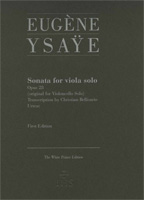|

|
Eugčne Ysa˙e,
Sonata for viola solo
Opus 28 (original for Violoncello Solo)
Transcription by Christian Bellisario
Urtext
First Edition edited by Christian Bellisario
Fingering and bowing by Jakov Zats
The White Prince Edition 201
ISMN M-000-00095-7
Order number
WPE201
|
Legendary interpreter, esteemed professor of violin at the Bruxelles Conservatoire, but also conductor and composer, Eugčne Ysa˙e (Liege 1858 - Bruxelles 1931) has left the mark of his charismatic personality upon the history of the violin.
Among his best-loved and most often performed composition certainly can be found the Six Sonates pour violon seul op. 27.
Composed in 1923 the Six Sonates are dedicated to six renowned violinist colleagues: in order, the first to Joseph Szigeti, the next to Jacques Thibaud, then to Georges Enesco, Fritz Kreisler, Mathieu Crickboom, and Manuel Quiroga. According to the intention of the author, the form and musical content of each sonata was supposed to be closely related to the personality of the violinist to whom it was dedicated.
“It was after hearing Joseph Szigeti [Hungarian violinist, born in Budapest in 1892, died in Lucerne in 1973] play a Bach Sonata that Ysa˙e was moved to write his own Sonatas. “I found in Szigeti that rare combination of the musician and the virtuoso. As an artist he seemed conscious of a high mission into which he put all his faith and he placed technique entirely at the service of musical expression.” [Ysa˙e, his life, work and influence, Antoine Ysa˙e and Bertram Ratcliffe, Heinemann].
The form of the Sonate pour violoncello seul op. 28, composed the same year as the violin solo sonatas, and its musical writing rich in Baroque stylistic elements with tightly woven polyphonic voices, comes very close to the first of the six sonatas for violin solo (it, too, being in four movements, opening with a GRAVE and concluding with a FINALE CON BRIO).
Scattered throughout the lush musical landscape are evocative passages and refined harmonic resolutions, from the solemn beginning of the first movement, through the mysterious Intermezzo, continuing into the obscure shadows of the Recitativo and all the way through the cadenzas and the fugato of the last movement.
We know from many reports that Ysa˙e loved the warm, deep tone of the cello which he himself knew how to play. Prof. Lev Ginsburg in Ysa˙e [Paganiniana Publications] reports that “in his youth Eugčne Ysa˙e studied several instruments besides the violin, and he knew the cello very well. He liked this instrument (incidentally, one of his sons studied the cello) and his interest in it was further stimulated by his friendly contacts with many prominent cellists, among them Gérardy, Pollain, Joseph Servais, Joseph Hollmann, André Hekking, Anatoly Brandukov, Jacques Gailliard, Pablo Casals”.
The Sonate pour violoncelle seul op. 28 was dedicated to Maurice Dambois, renowned Belgian cellist, composer and member of the Trio Čugene Ysa˙e and of the Quatuor Čugene Ysa˙e, who most probably prepared the fingerings for the first edition.
There are however various indications that seem to relate the Sonata op. 28 with the viola.
The viola because of its particular characteristics, the tuning (an octave higher than that of the cello) and the ‘manoeuvrability’ identical to that of the violin, represents an evident midpoint between the violin and the cello.
A careful study of the few fingerings present in the remaining manuscript, written in ink or added in pencil, is the first confirmation of our hypothesis.
Contrary to the fingerings printed in the first edition, in the autograph manuscript we never find one of the peculiar technique of the cello: the use of thumb position, not even in the passages where it would be the easiest and quickest solution. Difficult passages are annotated, almost as though for personal use, with fingerings that require the use of only four fingers with some extensions. It is very probable, therefore, that Ysa˙e executed the Sonata with the viola during its composition or at least in the final phases of its preparation.
Sometimes it is the same musical text that seems to demonstrate our thesis: the beginning of the third movement In modo di Recitativo, for example, sounds much more intelligible on the viola, while the result is darker and more gloomy in colour with the cello.
Or it could be the technical indications in the musical writing that takes us in that direction, as in measure 9, 10 and 11 of the fourth movement Finale con brio: here the polyphony, with the alternation of two voices, on the one hand uses the open strings d and g as pedal tones and on the other hand places the principal voice entirely on the third string, as in numerous similar passages present in the sonatas for violin solo. Such executions are undoubtedly much more comfortable with the viola than with the cello.
Therefore, if this transcription of the Sonata op. 28 is occasion of enlargement of the viola solo repertoire, it was done also so that the exchange of viewpoints between its new interpreters and cellists leads to a profound understanding of the musical and expressive meaning of the Sonata and, from the perspective of the evolution of instrumental techniques, to a more precise understanding of its technical requirements.
Listen to the Eugčne Ysa˙e's Sonata for Viola solo
Performer Jakov Zats:
Buy Eugčne Ysa˙e's Sonata for Viola solo online

